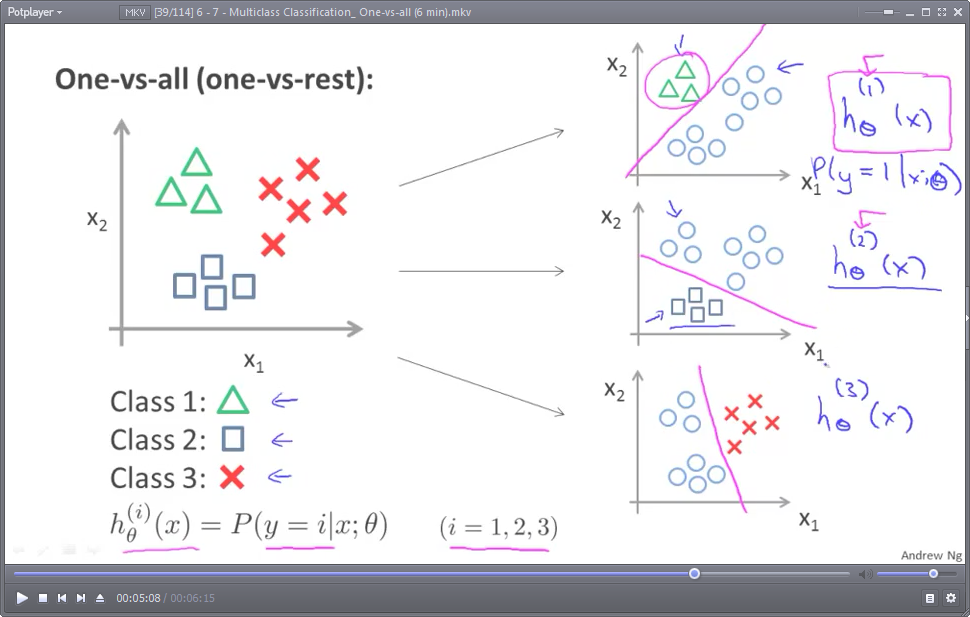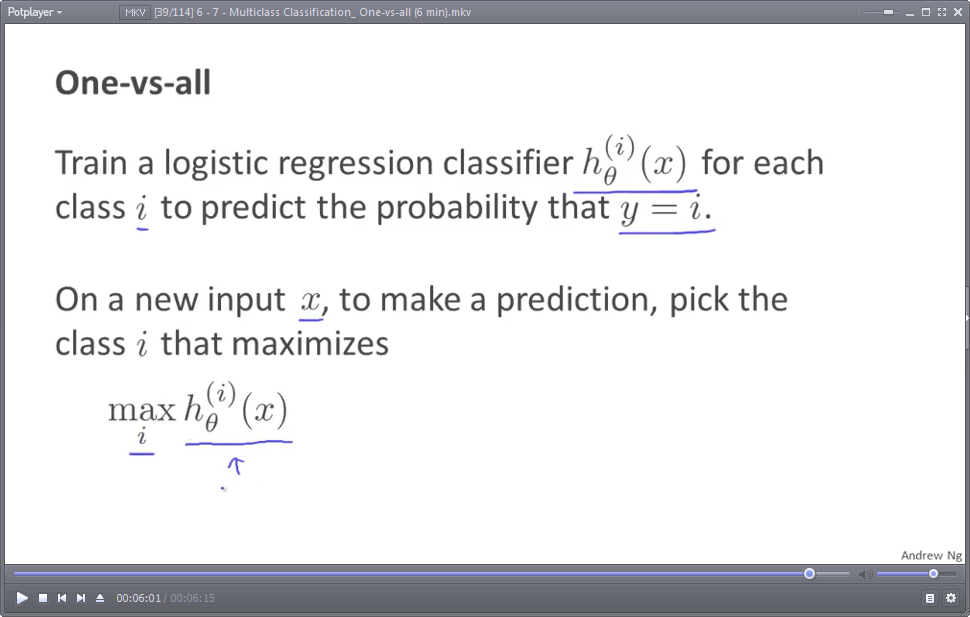stanford coursera 机器学习编程作业 exercise 3(逻辑回归实现多分类问题)
本作业使用逻辑回归(logistic regression)和神经网络(neural networks)识别手写的阿拉伯数字(0-9)
关于逻辑回归的一个编程练习,可参考:Stanford coursera Andrew Ng 机器学习课程编程作业(Exercise 2)及总结
下面使用逻辑回归实现多分类问题:识别手写的阿拉伯数字(0-9),使用神经网络实现:识别手写的阿拉伯数字(0-9),请参考:神经网络实现
数据加载到Matlab中的格式如下:

一共有5000个训练样本,每个训练样本是400维的列向量(20X20像素的 grayscale image),用矩阵 X 保存。样本的结果(label of training set)保存在向量 y 中,y 是一个5000行1列的列向量。
比如 y = (1,2,3,4,5,6,7,8,9,10......)T,注意,由于Matlab下标是从1开始的,故用 10 表示数字 0
①样本数据的可视化
随机选择100个样本数据,使用Matlab可视化的结果如下:

②使用逻辑回归来实现多分类问题(one-vs-all)
所谓多分类问题,是指分类的结果为三类以上。比如,预测明天的天气结果为三类:晴(用y==1表示)、阴(用y==2表示)、雨(用y==3表示)
分类的思想,其实与逻辑回归分类(默认是指二分类,binary classification)很相似,对“晴天”进行分类时,将另外两类(阴天和下雨)视为一类:(非晴天),这样,就把一个多分类问题转化成了二分类问题。示意图如下:(图中的圆圈 表示:不属于某一类的 所有其他类)

对于N分类问题(N>=3),就需要N个假设函数(预测模型),也即需要N组模型参数θ(θ一般是一个向量)
然后,对于每个样本实例,依次使用每个模型预测输出,选取输出值最大的那组模型所对应的预测结果作为最终结果。
因为模型的输出值,在sigmoid函数作用下,其实是一个概率值。,注意:hθ(1)(x),hθ(2)(x),hθ(3)(x)三组 模型参数θ 一般是不同的。比如:
hθ(1)(x),输出 预测为晴天(y==1)的概率
hθ(2)(x),输出 预测为阴天(y==2)的概率
hθ(3)(x),输出 预测为雨天(y==3)的概率

③Matlab代码实现
对于上面的识别阿拉伯数字的问题,一共需要训练出10个逻辑回归模型,每个逻辑回归模型对应着识别其中一个数字。
我们一共有5000个样本,样本的预测结果值就是:y=(1,2,3,4,5,6,7,8,9,10),其中 10 代表 数字0
我们使用Matlab fmincg库函数 来求解使得代价函数取最小值的 模型参数θ
function [all_theta] = oneVsAll(X, y, num_labels, lambda)
%ONEVSALL trains multiple logistic regression classifiers and returns all
%the classifiers in a matrix all_theta, where the i-th row of all_theta
%corresponds to the classifier for label i
% [all_theta] = ONEVSALL(X, y, num_labels, lambda) trains num_labels
% logisitc regression classifiers and returns each of these classifiers
% in a matrix all_theta, where the i-th row of all_theta corresponds
% to the classifier for label i
% Some useful variables
m = size(X, 1);% num of samples
n = size(X, 2);% num of features
% You need to return the following variables correctly
all_theta = zeros(num_labels, n + 1);
% Add ones to the X data matrix
X = [ones(m, 1) X];
% ====================== YOUR CODE HERE ======================
% Instructions: You should complete the following code to train num_labels
% logistic regression classifiers with regularization
% parameter lambda.
%
% Hint: theta(:) will return a column vector.
%
% Hint: You can use y == c to obtain a vector of 1's and 0's that tell use
% whether the ground truth is true/false for this class.
%
% Note: For this assignment, we recommend using fmincg to optimize the cost
% function. It is okay to use a for-loop (for c = 1:num_labels) to
% loop over the different classes.
%
% fmincg works similarly to fminunc, but is more efficient when we
% are dealing with large number of parameters.
%
% Example Code for fmincg:
%
% % Set Initial theta
% initial_theta = zeros(n + 1, 1);
%
% % Set options for fminunc
% options = optimset('GradObj', 'on', 'MaxIter', 50);
%
% % Run fmincg to obtain the optimal theta
% % This function will return theta and the cost
% [theta] = ...
% fmincg (@(t)(lrCostFunction(t, X, (y == c), lambda)), ...
% initial_theta, options);
%
initial_theta = zeros(n + 1, 1);
options = optimset('GradObj','on','MaxIter',50);
for c = 1:num_labels %num_labels 为逻辑回归训练器的个数,num of logistic regression classifiers
all_theta(c, :) = fmincg(@(t)(lrCostFunction(t, X, (y == c),lambda)), initial_theta,options );
end
% =========================================================================
end
lrCostFunction,完全可参考:http://www.cnblogs.com/hapjin/p/6078530.html 里面的 正则化的逻辑回归模型实现costFunctionReg.m文件
下面来解释一下 for循环:
num_labels 为分类器个数,共10个,每个分类器(模型)用来识别10个数字中的某一个。
我们一共有5000个样本,每个样本有400中特征变量,因此:模型参数θ 向量有401个元素。
initial_theta = zeros(n + 1, 1); % 模型参数θ的初始值(n == 400)
all_theta是一个10*401的矩阵,每一行存储着一个分类器(模型)的模型参数θ 向量,执行上面for循环,就调用fmincg库函数 求出了 所有模型的参数θ 向量了。
求出了每个模型的参数向量θ,就可以用 训练好的模型来识别数字了。对于一个给定的数字输入(400个 feature variables) input instance,每个模型的假设函数hθ(i)(x) 输出一个值(i = 1,2,...10)。取这10个值中最大值那个值,作为最终的识别结果。比如g(hθ(8)(x))==0.96 比其它所有的 g(hθ(i)(x)) (i = 1,2,...10,但 i 不等于8) 都大,则识别的结果为 数字 8
function p = predictOneVsAll(all_theta, X)
%PREDICT Predict the label for a trained one-vs-all classifier. The labels
%are in the range 1..K, where K = size(all_theta, 1).
% p = PREDICTONEVSALL(all_theta, X) will return a vector of predictions
% for each example in the matrix X. Note that X contains the examples in
% rows. all_theta is a matrix where the i-th row is a trained logistic
% regression theta vector for the i-th class. You should set p to a vector
% of values from 1..K (e.g., p = [1; 3; 1; 2] predicts classes 1, 3, 1, 2
% for 4 examples)
m = size(X, 1);
num_labels = size(all_theta, 1);
% You need to return the following variables correctly
p = zeros(size(X, 1), 1);
% Add ones to the X data matrix
X = [ones(m, 1) X];
% ====================== YOUR CODE HERE ======================
% Instructions: Complete the following code to make predictions using
% your learned logistic regression parameters (one-vs-all).
% You should set p to a vector of (from 1 to
% num_labels).
%
% Hint: This code can be done all vectorized using the max function.
% In particular, the max function can also return the index of the
% max element, for more information see 'help max'. If your examples
% are in rows, then, you can use max(A, [], 2) to obtain the max
% for each row.
%
[~,p] = max( X * all_theta',[],2); % 求矩阵(X*all_theta')每行的最大值,p 记录矩阵每行的最大值的索引
% =========================================================================
end



